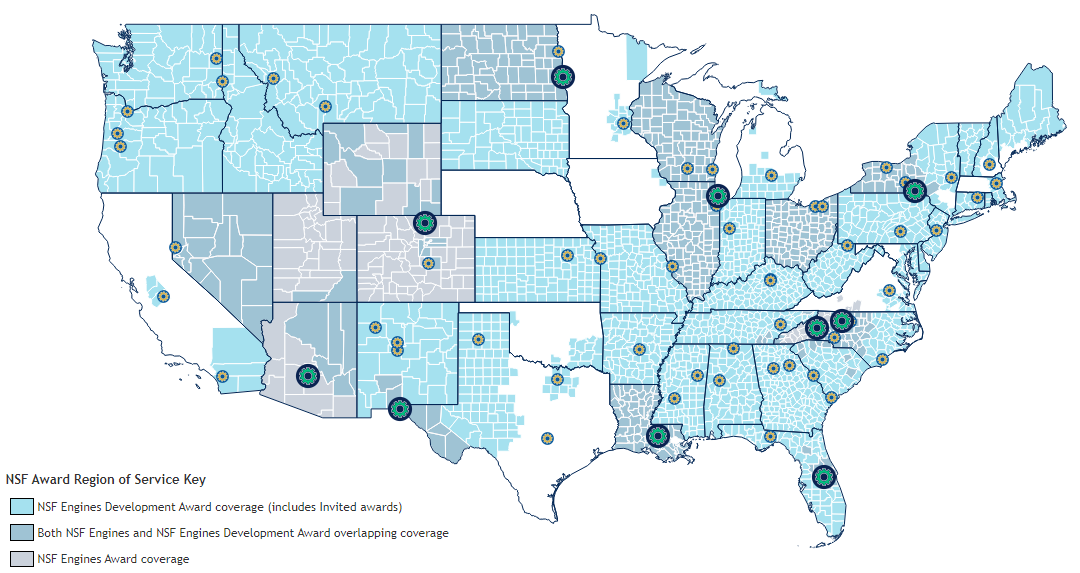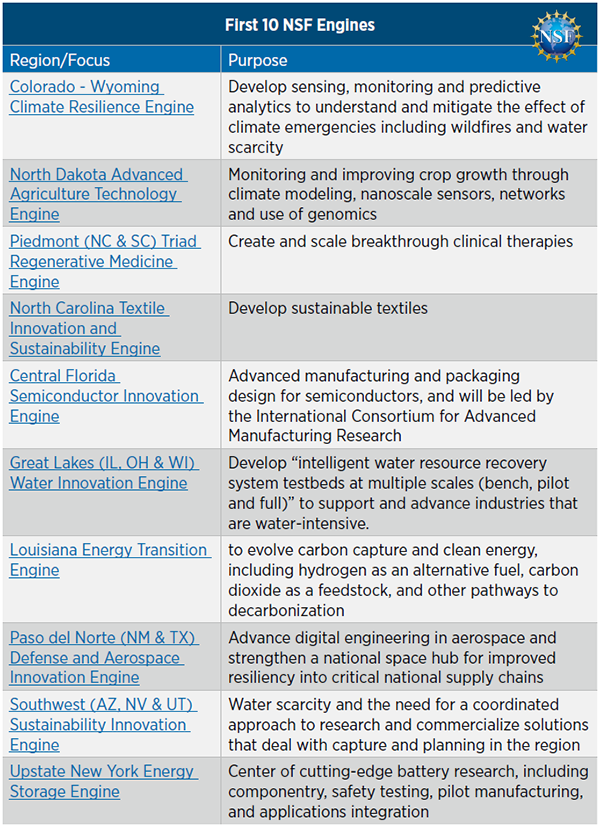February 26, 2024
Advanced Manufacturing, Climate Technology Lead Commerce and National Science Foundation Awards


Over the last 30 days, the Department of Commerce and the National Science Foundation (NSF) released a series of funding announcements. The initiatives and projects—whether large or small—focus on collaboration, and include academic institutions, corporations, and nonprofits and many new partners.
The NSTC, as the centerpiece of the CHIPS R&D program, will bring together and support government, industry, labor, customers, suppliers, educational institutions, entrepreneurs, and investors to accelerate the pace of new innovations, lower barriers to participation in semiconductor R&D, and directly address fundamental needs for a skilled, diverse semiconductor workforce.
The White House,
February 9
The first major building block, and the focus of $5 billion in federal investment and a February 9 White House announcement, is domestic semiconductor manufacture, research and building the skilled workforce to make it happen. The CHIPS and Science Act called for the establishment of a public-private partnership, the National Semiconductor Technology Center (NSTC), which was announced February 9. NSTC is a consortium that includes the US Departments of Commerce, Defense and Energy, the NSF, and the private sector. As Secretary of Commerce Raimondo stated in the NSTC announcement, “With strategic investments in R&D complementing targeted industry incentives, CHIPS for America will not only bring semiconductor manufacturing back to the U.S. – it will keep it here for good.”
DEPARTMENT OF COMMERCE
CHIPS Act projects include over $200 million for a semiconductor manufacturing “digital twin”, which will be a first-of-its-kind, and environment for researchers to experiment with physical manufacturing processes at a lower cost. The CHIPS Research and Development (CHIPS R&D) Office at the National Institute for Standards and Technology (NIST) published a Notice of Intent (NOI) on February 1 to invest at least $200 million over a 5-year period in an open competition for a CHIPS Manufacturing USA Institute to create a digital twin construct. CHIPS R&D expects to publish a Notice of Funding Opportunity (NOFO) in the second quarter of calendar 2024. The intent of the NOI is to provide lead- time for collaborations to be developed in advance of the NOFO. NIST held an industry day on February 12 and will post the introductory session and new announcements at https://www.nist.gov/chips.
NIST also published a $300 million NOI for the CHIPS National Advanced Packaging Manufacturing Program (NAPMP) Materials and Substrates Research and Development on February 1, which will be distributed in multiple awards of up to $100 million each over five years. A key question for potential solutions will be the ability to “scale up and scale out”—from shrinking the size of features to expanding the number of chips on a substrate. Commerce states that the NOFO will be published in March, with a 35- day deadline for concept papers.
The CHIPS Metrology projects are focused on NIST measurement standards and instruments that address needs across the microelectronic industry. NIST has provided $100 million to 29 projects. NIST has also published a concept plan, Building a Metrology Exchange to Innovate in Semiconductors (METIS): A Vision for the CHIPS Metrology Program Data Exchange and invited users to comment on their planned data exchange system, which is intended to support sharing and exchanging data and models so products can be brought to the marketplace. Comments are due Feb. 16.
Several projects are farther along in the procurement process. Commerce has signed Preliminary Memoranda of Terms (PMTs) with Microchip Technologies for semiconductor fabrication ($162 million for two locations) and with BAE Systems for modernizing the company’s microelectronic center ($35 million).
NATIONAL SCIENCE FOUNDATION (NSF) REGIONAL ENGINES
On January 29, NSF announced the first NSF Regional Innovation Engines awards to ten teams across the country. In the first phase, each team will receive $15 million over two years, and be eligible for up to $160 million over ten years. As NSF explains, an NSF Engine is “a regionally-centered, multi-sector coalition of partners spanning industry, academia, government and non-profit organizations working together to spur place-based research, innovation and workforce development.” NSF Engines are illustrated by the large green circles on Figure 1, in the NSF map.


Figure 1: NSF Engines and Development Awards, Source NSF
A quick review of the 10 NSF Engines showcases the programs’ focus on geographic, technical, and organizational diversity. The 10 Engines include 476 separate organizations as partners (154 for-profit partners), and 331 organizations that are investing funding in the projects (in addition to federal funding). The most referenced key technologies for the NSF Engines are Advanced Materials, Advanced Manufacturing, Advanced Energy and Industrial Efficiency, and Artificial Intelligence. However, projects also include AI, Advanced Computing, Quantum, Disaster Prevention and Mitigation, Advanced Communications, Biotech, and Cybersecurity technologies. Six of the 10 Engines include partners that are new to NSF funding, and all include Community Colleges as partners. The ten inaugural NSF Engines receiving $15 million are included in the table below.


Chart I. Source: NSF
NSF also announced 15 additional $1 million “development awards” on January 29, which will join the 44 existing development awards. NSF considers the $1 million development awards to be seed money to help recipients develop future NSF Engines proposals. The 15 invitees’ proposed projects are spread around the country and include advanced manufacturing for building technology, sustainability, and pharmaceutical production; quantum technology; disaster prevention, climate technologies, and mitigation projects; and industrial efficiency projects.
NSF CONVERGENCE ACCELERATOR
NSF’s Directorate for Technology, Innovation and Partnerships (TIP) announced three sets of new awards on February 6, 8, and 13, including $35 million for agricultural technology development, $10.4 million for chemical and biological sensing related to hazardous material removal, and $9.75 million for biology-inspired tech solutions. The Convergence Accelerator program is designed to accelerate moving solutions from basic discovery to adoption, focused on collaboration to deal with problems of broad societal impact. It includes 10 tracks, organized by cohort-year with new tracks added annually. The current tracks include AI-based solutions, Quantum Technology, Trust in Communication Systems, 5G Infrastructure, Opportunities for People with Disabilities, Sustainable Materials, and Food and Nutrition Security. Convergence Accelerator grant and solicitation information is available here.
We envision the creation of cost-effective, versatile and large-scale solutions that can monitor and analyze in real-time and can be deployable across a wide range of indoor and outdoor environments.
Convergence Accelerator Head Maughan,
February13
The $35 million in agricultural technology development grants include a $5 million award to each of seven teams. Highlights include:
- CropSmart, a digital twin system to support efficient crop planting and The twin is based on near-real time remote observations of cropping systems, and uses artificial intelligence and machine learning-based modeling and simulations.
- Cultivate IQ is an AI data transformation platform that looks at crops from a supply chain perspective, bringing sales and production data together to understand and manage regional food supplies.
- SENS-D is a food safety focused technology that includes rapid pathogen sensors that link with visualization, prediction and optimization capabilities.
All Phase I awards for the 2023 grants are listed by NSF and proposals for Phase II of the 2023 Cohort are due August 30, 2024. The projects are varied, including Quantum-enhanced Sensing and Species Identification of Bio-aerosols, Engineered Microbial Sensors for Assessing Water Quality, and Slime-mold Inspired Self-assembled Conveyor System for Flood Response. Phase II applications are open only to Phase I participants. Last, on February 13 NSF announced a nearly $20 million award for technology and infrastructure to use X-ray fluorescence to study living systems, such as plants, in a depth not possible today. The new facility, X-rays for Life Sciences, Environmental Sciences, Agriculture and Plant Sciences (XLEAP), will be located at Cornell and will house new instrumentation able to analyze rare earth elements and elements with high atomic numbers.
SUMMARY
The CHIPS Act, infrastructure bills, and annual appropriations combine to provide major opportunities for R&D investment through the Department of Commerce and NSF. Both are looking for first-time participants and cooperators from regions across the nation, as well as rural and urban partners that will link to the needs of their communities. They are also keen for commitments of additional investment over the federal funds, although cost shares are generally not required. The bottom line is that information technology—whether AI, cybersecurity, enabling quantum systems, or contributions to advanced manufacturing—is embedded in nearly every solution. Partnerships and participation in consortia are key to success in being a part of the new tranche of funding opportunities that are rolling out now and for the next several years.